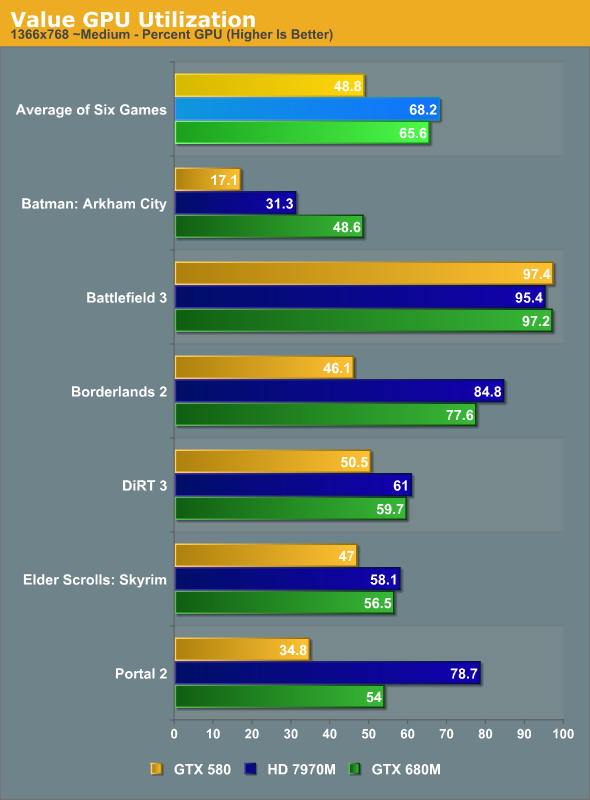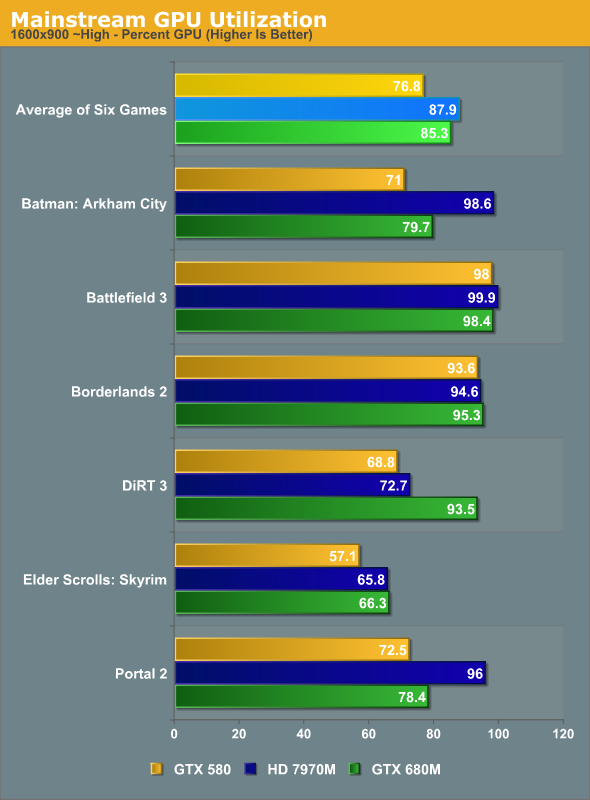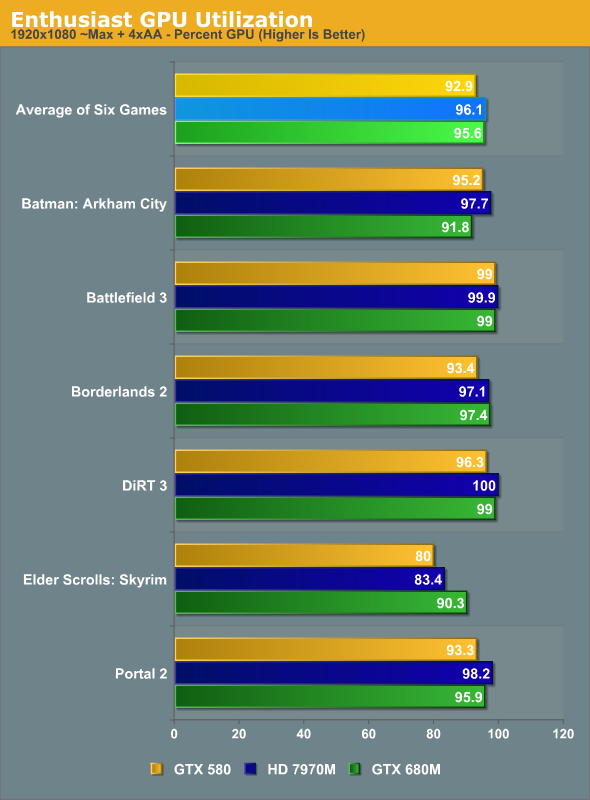AVADirect Clevo P170EM Part 2: GTX 680M Grudge Match
by Jarred Walton on October 15, 2012 6:50 PM ESTGPU Utilization Investigations
One of the issues we experienced with the initial drivers on the Radeon HD 7970M was lower than expected performance, and many users/owners of the 7970M Clevo notebooks have pointed towards GPU utilization as being the culprit. That seemed a bit odd when I first heard about the topic, as low GPU utilization should be a symptom of lower than expected performance rather than the cause—basically, if the GPU is capable of running at 150 FPS at certain settings but it’s only running at 75 FPS, you’d expect the GPU use to be around 50%. With the initial P170EM review, I did some quick checking on GPU utilization and found that, yes, it seemed low. With the Hotfix driver (which still hasn’t reached the public, though we’re hearing “this week”—meaning, some time during October 15-19), we also noted that GPU utilization did improve. Nevertheless, GPU utilization isn’t “always 90% or more”, which is what some people have been asking for.
To investigate this issue more thoroughly, I tested GPU utilization across our three benchmark settings in six of the games. For these tests, I’m not using built-in benchmarks or even FRAPS runs; instead, I played the same segment of each game in a pattern that was as close to the same as possible, and I did this over a longer segment of the games: typically at least two minutes of gameplay, with a decent amount of “action” as appropriate.
After testing the P170EM with both HD 7970M and GTX 680M, I noticed that GPU use was relatively consistent but still occasionally low. At that point it seemed that Enduro and Optimus might be the cause of lower than expected GPU utilization. The other possibility of course is that the CPU and other areas were the bottleneck and that the GPU simply wasn’t able to get enough data to work on quickly enough. To test whether Optimus/Enduro might be causing issues, I added my own gaming desktop system into the mix; it has an i7-965X clocked at 3.65GHz, 12GB (6x2GB) DDR3-1333 RAM, and a GeForce GTX 580 GPU. I ran the same gaming tests on all three systems, and here are the results:



Not surprisingly, GPU use is lower by far at the Value settings—1366x768 and ~Medium detail isn’t likely to tax the GPUs all that much, and the desktop system (with a faster GPU but potentially slower CPU) ends up with the lowest overall GPU utilization. The Mainstream testing pushes the GPUs quite a bit more, while at our Enthusiast settings most of the games are hitting 95% or higher GPU use. Looking at the games individually, we also notice that games that are typically more dependent on CPU performance (e.g. Skyrim), or at least not as demanding graphically (e.g. Portal 2), have lower GPU utilization.
I didn’t run a full set of tests using the earlier AMD 7970M drivers, but I can tell you that the Value and Mainstream results would be much lower, and even the Enthusiast settings are probably in the low 90s or high 80s on average. With the Hotfix driver installed, however, AMD’s 7970M ends up being the “best” overall at achieving high GPU utilization. I’m not sure that really matters all that much, as the real story is gaming performance. Whether low GPU utilization causes low frame rates or the low frame rates reduce GPU utilization, either way the fix is generally going to involve reworking the graphics drivers.










58 Comments
View All Comments
Harmattan - Wednesday, October 17, 2012 - link
I've now owned a p150hm with a 7970m, an m17x with a 7970m and 680m, an m18x with dual 7970m and another (my current) m18x with dual 680ms. After having spent many hours with each config, , my initial assertions stand...-if you're going single card and Clevo, get the 680m: although the drivers are almost comparable between the two cards, Enduro power management (and the inability to turn it off) is a whole heap of wrong.
-If you're going single card and AW, get the 7970m: since Enduro issues are not there, the price increase of the 680m is not justified.
-If you're going dual cards on either Clevo or AW, go 680m. 7970 CF drivers are a mess in many games and I experienced many issues (even after replaced cards)
All in all, I am happier and had less problems with the 680m on all configs. When the 7970m ran well, it is comparable, but that is rare.
The above points are just based on pure gaming performance at stock. If you're OC-ing, compare the desktop performance of a 7870 vs. GTX 670 - both cards are beasts, but the GTX 670 is +/-20% faster in most situations (and runs cooler).
TokamakH3 - Wednesday, October 17, 2012 - link
Would that fly in a desktop video card review? "Well, the Nvidia card is $574 while the AMD card is $300, but since the desktop you'll put it in will be $1975 vs $2249, there's only a 14% price difference, so we'll only look for a 14% performance difference"
That really makes no sense at all.
TokamakH3 - Wednesday, October 17, 2012 - link
Haha, dead horse. Should read before commenting, would delete the post if I could.cartmanasan - Thursday, October 18, 2012 - link
Don't know why no one covers professional applications like Maya, 3DSM etc. nVidia has got worse performance than their own previous cards. Have seen this going around in many forums. Gaming notebooks are well placed to be workstation/DTRs. No Mention of GPU Boost technology of nVidia as well. A comparison of overclocking would have been better too.transphasic - Saturday, October 20, 2012 - link
The reason AMD GPU's score far better than the Nvidia offerings this time around on business applications, is due to Nvidia's new Kepler-based designs are more gaming-oriented in it's focus, as opposed to the older Fermi-based chips, so that is the reason why, from what I have seen as an explanation from NBR.com for AMD to win this particular battle.Kepler-based GPU's are more for gaming performance, but the AMD fares better on business-related programs and applications.
tential - Monday, November 19, 2012 - link
I think I'm a little late to the party but the reviewers opinion in the Conclusion is just that. An OPINION. I usually skip to the conclusion pretty fast because I'd like to hear their opinion. The raw numbers is usually not enough to make a decision. If so, I'd had said "The 680M is faster but I think the 7970 is good enough for me." Now after reading further and factoring in driver support as well as the other issues with AMD, I think it'd be worthwhile to spend the extra money.I understand the gripe of using the GFX performance as the only thing that matters when considering the upgrade however but I don't think that's what the reviewer was doing. A laptop is used for many other things other than just gaming. Even a gaming laptop is. Hell, my gaming laptop is currently not even used for much gaming as I do a lot of other things on it. I think it's important for people to take the reviewers opinion in context though and to know that you have to make your own opinion. It's obvious that if you do a lot of other things other than gaming than maybe you can't justify the upgrade. However, if you primarily use it for gaming maybe you can. I think an update article in a couple of months would be nice though.
Also:
IMO, some things I'd like Anandtech to start including though would be an adjusted FPS page. This page would should FPS but would weight FPS above 60 lower. I really don't think there is a point in saying "Wow this card runs a game at 120 fps and this card runs it at 100 so the first card is what you should get!" Why not get the card that runs it at 100 fps when all I need is 60 FPS anyway right? I know this can be used to say that a card may run future games better but sometimes I'd like to know just about current games.
Hrel - Wednesday, January 2, 2013 - link
How did you measure GPU utilization? As far as I know FRAPS and the like only give FPS and admin tools don't have an option to add GPU to the list. So how did you do it? What did you use?Maybe it's in the article somewhere, but I'm at work and can't comb through the whole thing.
Hrel - Wednesday, January 2, 2013 - link
Every time you talk about what a hassel it is to carry around a laptop I imagine a little hobbit stuggling to pick up something (a large watermelon) just to have Argorn come and pick it up with one hand. It's such a none issue for me I would never even think to talk about it. Yet you go on like anything but an ultrabook just isn't portable. Lol. No point really, it just amuses me.My laptop bag is generally 30+ lbs and I never have any kind of issue carrying it around all day at a convention or airport or whatever. I'm curious if you're in the minority on this or I am. I mean, does it really matter if the thing weighs 6lbs or 11lbs? I can barely even tell the difference.